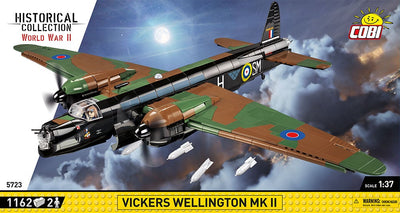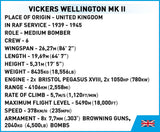Model Spec.
DISCONTINUED - WHILE STOCKS LAST THEN OUT OF PRODUCTION UNTIL FURTHER NOTICE.
- 1162 bricks
- 2 figures
- 1:37 scale
- Bodywork with pad printing
- Block with printed name of the plane
- Easy-to-follow instruction manual
- Compatible with other leading brands of construction blocks
History.
The Vickers Wellington Mk II, a pivotal British medium bomber, played a crucial role during the early years of World War II. Designed by Vickers-Armstrongs' chief designer, Sir Barnes Wallis, the Wellington was notable for its geodetic airframe construction, which provided exceptional strength and durability. The Mk II variant, specifically, was introduced to enhance the aircraft's performance and operational effectiveness.
The Wellington's design was revolutionary for its time, featuring a geodetic framework made of duralumin alloy. This lattice structure, inspired by principles of geodesy, provided the aircraft with superior resilience against damage. The Mk II variant was developed as an improvement over the original Mk I, primarily to incorporate the more powerful Rolls-Royce Merlin X engines, which offered better performance at higher altitudes and improved reliability.
First flown in March 1939, the Wellington Mk II entered production shortly thereafter. It retained the twin-engine configuration, with each Merlin X engine producing 1,145 horsepower. The aircraft had a wingspan of 86 feet and a length of 64 feet, capable of carrying a bomb load of up to 4,500 pounds. The defensive armament included nose, tail, and waist gun positions, manned by .303 inch Browning machine guns.
The Wellington Mk II saw extensive service with the Royal Air Force (RAF), particularly in Bomber Command. It was one of the mainstay bombers during the early bombing campaigns against Germany, including the infamous raids on Berlin and Hamburg. The aircraft's durability was highlighted in several missions where it returned to base despite sustaining significant damage.
The Wellington Mk II's operational range of about 1,500 miles allowed it to reach key strategic targets across Europe. Its service was not limited to nighttime bombing raids; it also participated in anti-submarine patrols and maritime reconnaissance, showcasing its versatility.
The Wellington Mk II was eventually succeeded by more advanced models, but its impact was profound. It demonstrated the potential of geodetic construction and the effectiveness of the Merlin engines in medium bombers. Over 400 Mk IIs were produced, and the lessons learned from their deployment informed the development of subsequent bomber designs. The Wellington's robust design and operational success cemented its place in aviation history as a resilient and versatile workhorse of the RAF during World War II.
Reviews.
Shipping.
- BrickTanks offers multiple shipping options. Visit the following Shipping page for more details.
 Skip to content
Skip to content

























